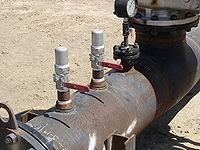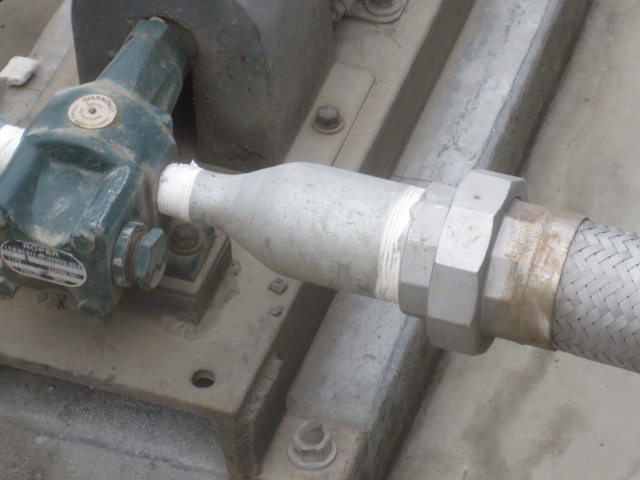Threaded Fitting
Forged Fittings Threaded Class Types
| ||||
|---|---|---|---|---|
| Pressure Class | 2000 | 3000 | 6000 | 9000 |
| Socket Fitting | - | 80/XH | 160 | XXH |
| Threaded Fitting | 80/XH | 160 | XXH | - |
Threaded pipe fittings, abbreviated as THRDF, are a type of pipe connection used to join pipes and other components in a plumbing or piping system. These fittings have threaded ends that allow them to be screwed onto the threaded ends of pipes or other fittings, creating a secure and leak resistant connection. Threaded pipe fittings are commonly used in a variety of applications, including plumbing, industrial processes, and even in some residential plumbing systems.
Forged Fittings Threaded Sizes
| ||||
|---|---|---|---|---|
| Fitting | 2000 | 3000 | 6000 | 9000 |
| 45 Elbow | 1/8 - 4 | 1/8 - 4 | 1/8 - 4 | - |
| 90 Elbow | 1/8 - 4 | 1/8 - 4 | 1/8 - 4 | - |
| Bushing, Flush | 1/8 - 4 | 1/8 - 4 | 1/8 - 4 | - |
| Bushing, Hex | 1/8 - 4 | 1/8 - 4 | 1/8 - 4 | - |
| Cap, Round | - | 1/8 - 4 | 1/8 - 2 | - |
| Coupling, Full | - | 1/8 - 4 | 1/8 - 4 | - |
| Coupling, Half | - | 1/8 - 4 | 1/8 - 4 | - |
| Cross | 1/8 - 4 | 1/8 - 4 | 1/8 - 4 | - |
| Lateral | - | 1/4 - 2 | 1/4 - 1 1/4 | - |
| Plug. Hex Head | 1/8 - 4 | 1/8 - 4 | 1/8 - 4 | - |
| Plug, Round Head | 1/8 - 4 | 1/8 - 4 | 1/8 - 4 | - |
| Plug, Square Head | 1/8 - 4 | 1/8 - 4 | 1/8 - 4 | - |
| Reducer | - | 1/8 - 4 | 1/8 - 4 | - |
| Street Ell | - | 1/8 - 2 | 1/8 - 2 | - |
| Tee | 1/8 - 4 | 1/8 - 4 | 1/8 - 4 | - |
| Union | - | 1/8 - 3 | 1/8 - 2 | - |


- See Articles - List of Tags / List of Categories / List of Articles / List of Glossaries / Nomenclature and Symbols
Key Points about Threaded Pipe Fittings
Types of Threads - Threaded pipe fittings can have different types of threads, depending on the region and standards being used. Some common types include NPT (National Pipe Thread), BSP (British Standard Pipe), and BSPT (British Standard Pipe Taper). These threads are designed to create a tight seal when properly connected.Materials - Threaded pipe fittings are typically made from materials such as brass, stainless steel, carbon steel, or PVC, depending on the application and the substances being transported through the pipes. The choice of material depends on factors like corrosion resistance and pressure requirements.
Variety of Fittings - There is a wide range of threaded pipe fittings available to suit different needs. Some common types of threaded fittings include elbows, tees, couplings, unions, caps, and plugs. Each type serves a specific purpose in directing or controlling the flow of fluids through the piping system.
Installation - Installing threaded pipe fittings involves threading the fitting onto the pipe or another fitting. It's important to use thread sealant or Teflon tape on the threads to ensure a tight seal and prevent leaks. Over tightening can damage the threads, so it's crucial to apply the right amount of torque.
Advantages - Threaded pipe fittings are relatively easy to install and don't require soldering or welding, making them a popular choice for DIY projects and small plumbing repairs. They are also reusable, allowing for easy disassembly and reassembly if needed.
Disadvantages - While threaded fittings are convenient, they may not be suitable for high pressure or high temperature applications. The threads can become damaged over time, leading to leaks. In such cases, other types of connections like welded or flanged connections may be more appropriate.
Leak Prevention - Proper installation and the use of thread sealant are crucial for preventing leaks in threaded pipe fittings. Regular maintenance and inspection are also important to ensure the integrity of the connections.
Threaded Pipe Fitting Classes
Threaded pipe fittings are generally four inches and smaller. The reason for this size constraint is the pipe end needs to be threaded with a male type connection and die sizes are unobtainable in the larger diameters.
- 45 Elbow, 90 Elbow, Cross, Lateral, Tee
- Class 2000 - for use with Sch. 80 pipe.
- Class 3000 - for use with Sch. 160 pipe.
- Class 6000 - for use with Sch. XXH pipe.
- Half Coupling, Full Coupling, Reducer, Round Cap, Union, Hammer Lug Union
- Class 3000 - for use with Sch. 160 pipe.
- Class 6000 - for use with Sch. XXH pipe.
- Bushing (Flush and Hexagon)
- Bushings are not identified by class and can be used for all classes.
- Plug (Hexagon Head, Round Head and Square Head)
- Plugs are not identified by class and can be used for all three classes.
- Dimensions and tolerances in accordance with ANSI/ASME B16.11 - Forged Fittings, Socket-Welding and Threaded
- Specifications for carbon steel forgings in accordance with ASTM A105
- Threads in accordance with ANSI/ASME B1.20.1. All internal and external threads shall be threaded with American National Standard Taper Pipe Threads.
- FCS - forged carbon steel

